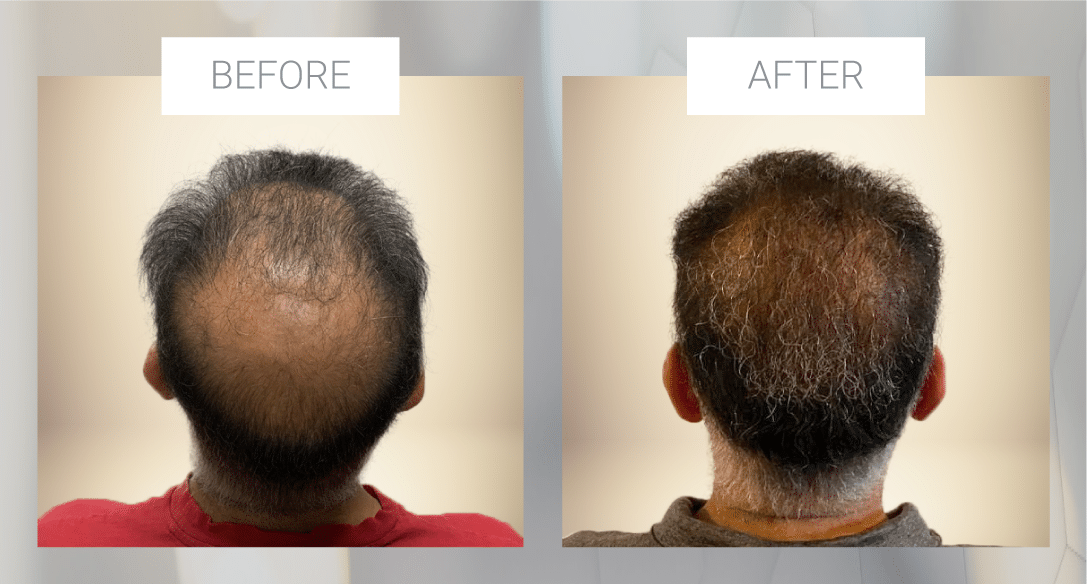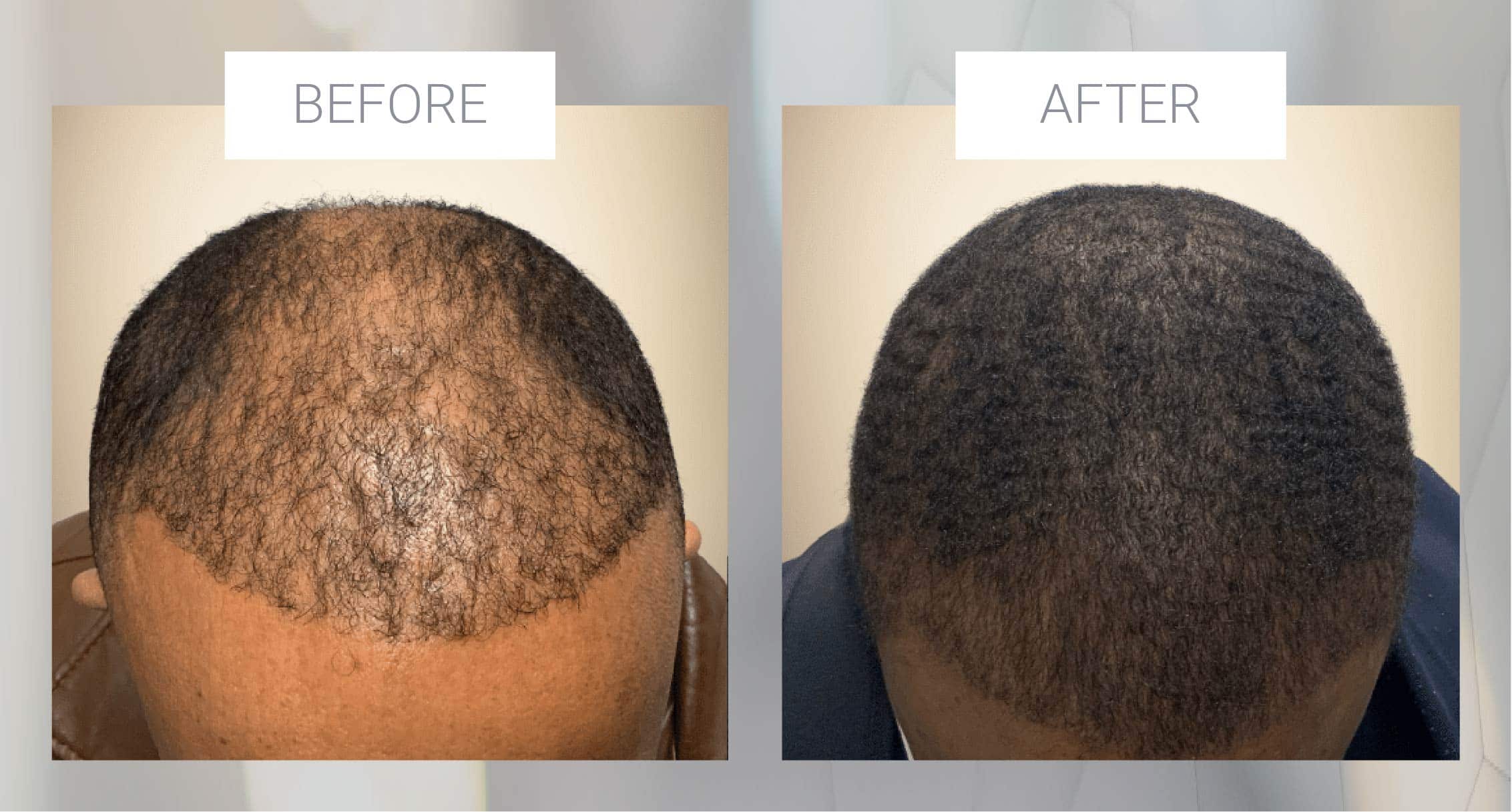If you’re researching hair restoration options, chances are you’ve heard about the FUE hair restoration technique, more formally known as Follicular Unit Extraction or, alternately, Follicular Unit Excision.
This preferred hair transplant surgery treatment is widely considered the new standard for modern hair restoration, displacing older methods like Follicular Unit Transplantation (FUT), commonly known as strip transplantation.
Unlike the strip hair transplant technique, Shave-Less FUE doesn’t leave an unsightly linear scar, and the precise technique allows for subtle blending and more natural-looking results.
If your goal is to achieve a thicker hair texture, natural-looking hairline reconstruction or even a full head of hair after progressive thinning, Shave-Less FUE can be a great choice.
But before you dive in, you may have some questions about this newer type of hair restoration surgery.
Common Questions About FUE Hair Restoration
Here at North Atlanta Hair Restoration, we hear some common questions about FUE from our prospective clients.
People often ask us things like:
- What is the success rate of the FUE hair transplant procedure?
- How long does the recovery process take, and is it difficult?
- How noticeable will it be that I’ve had hair transplant surgery?
- Will I have to shave my head for the procedure?
- Will I be able to keep my current hairstyle after hair restoration surgery?

The good news is that the Shave-Less FUE procedure has a high success rate for suitable candidates of all types.
This minimally invasive surgical technique boasts a short recovery time and a usually smooth and easy healing process.
Many patients are able to return to most of their daily activities immediately, including showering regularly and even washing their hair.
We usually tell patients they can resume moderate exercise after 4 days and get back to working out regularly or playing sports after day 7.
Results after the Shave-Less FUE procedure are usually quite robust, with a high follicular viability rate and a natural look that blends in with existing hair.
To ensure the best outcome, however, be sure to choose a hair restoration surgical practice where an experienced surgeon – not a surgical tech – oversees your procedure.
Shaving: The Downside to Traditional FUE Hair Transplant Surgery
There are some downsides to the regular FUE procedure, however, and they affect how we answer those last three questions about head shaving, noticeability and keeping your current hairstyle after FUE surgery.
Also known as traditional FUE, the original FUE hair restoration surgery requires shaving the head, or at least shaving the donor and recipient sites for the hair transplant.
For this reason, traditional FUE is also sometimes called Shaved FUE.
This means that you may look noticeably different for some time after the procedure, although you should be able to return to your original hairstyle once your hair grows out.
Now, for those who wear their hair pretty short or those already fond of wearing a hat, the change won’t be terribly noticeable, or at least, it won’t be noticeable for very long.
But for those with longer hair, including both women and men, the change can be quite jarring for the patient and, of course, noticeable to others.

Shave-Less FUE vs. Traditional FUE – Which is Better?
For anyone concerned about changing their hairstyle, shaving their head or having others potentially notice they’ve had a hair restoration procedure, Shave-Less FUE can seem like a gift from the heavens.
Also known as No-Shave FUE, the Shave-Less FUE procedure does not require shaving either the donor site or the recipient site – so you can keep your original hairstyle and normal hair length.
In short, this unshaven hair transplant method allows you to leave your hair restoration surgery appointment looking pretty much the same as when you walked in.
Is Shave-Less FUE as Successful as Traditional FUE?
Shave-Less FUE is just as successful as traditional FUE in terms of long-term hair viability and continued hair growth.
The success rate of Shave-Less FUE is comparable to that of traditional FUE, which is quite high indeed – provided the surgery is performed by a skilled surgical practitioner.
Both methods have been shown to have a high follicular viability rate and low transection rates, meaning that most of the transplanted individual hair follicles survive to grow healthy hair at their new site.
Long-term Shave-Less FUE results are comparable to those of traditional FUE, so you can expect the same great results and natural look.
The Shave-Less FUE method can be used on many different hair types and hair textures, too, making it a good choice for clients of a variety of ethnicities.
Is There a Downside to Shave-Less FUE?
Not really.
The Shave-Less FUE process does take a little longer than traditional FUE, so it may cost you more than a traditional FUE hair transplant.
For those who value privacy and discretion, however, it’s a pretty small price to pay.
If you have been hesitant to consider a hair transplant because you’re afraid to shave your head – or can’t due to work and social obligations – Shave-Less FUE may be just what you’ve been looking for.
Choosing an expert practitioner can help speed up the process and help you achieve more in a single session, so you can avoid repeat visits for larger hair restorations.
A doctor who has ample experience with Shave-Less FUE, the latest tools and technology, and a highly skilled surgical team will make the Shave-Less process smooth and efficient.
So be sure to choose the right FUE procedure for your needs and the right hair restoration surgeon, so you can get back to your regular routine and back to looking and feeling your best in no time at all.
Choose the Expert in Shave-Less FUE Hair Restoration Surgery
North Atlanta Hair Restoration is a physician-led practice dedicated to helping clients achieve their hair restoration goals.
Renowned hair loss treatment specialist Daniel A. Danyo, MD, MBA is one of fewer than 250 doctors who hold the title of Diplomate from the American Board of Hair Restoration Surgery, the only recognized certification for hair restoration surgery.
He and his team have placed over 4 million grafts, combining a surgeon’s skill with the artistic eye needed to achieve completely natural textural and placement results.
His results speak for themselves, and you can read the reviews left by his legions of happy clients – or check out his podcast to learn everything you need to know about all your hair restoration options.
Want to Know if Shave-Less FUE is Right Choice for You?
Get in touch with us now. You can call us at (678) 679-0028 or book online to schedule your virtual or in-person consultation.
During your visit, Dr. Danyo will assess your situation, answer all your questions, and advise you on whether Shave-Less FUE or another hair loss procedure might be right for you.

